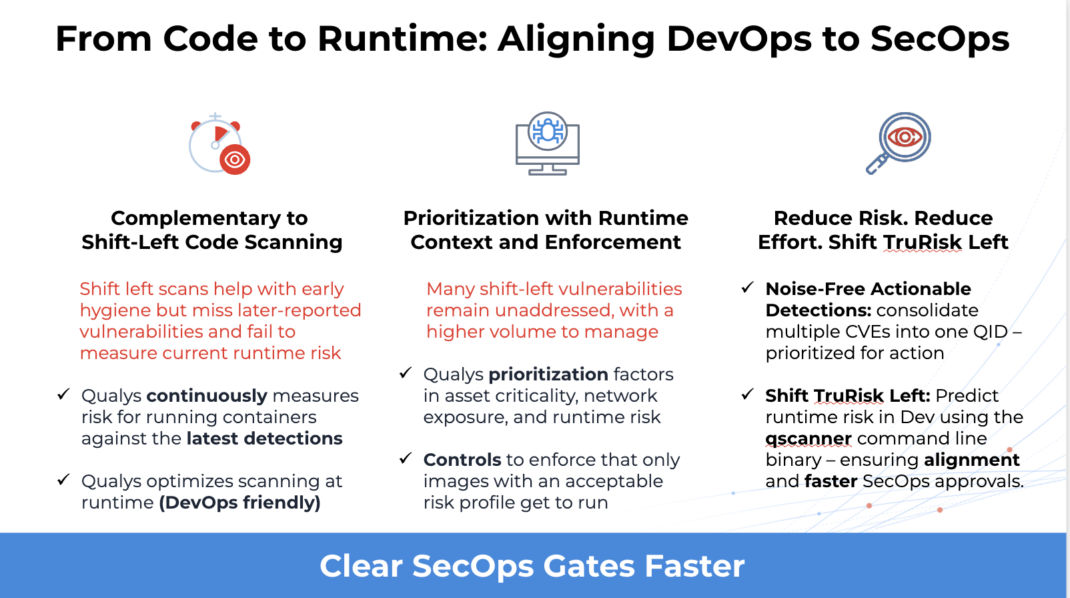How DevOps Can Move Fast and Stay Secure with TruRisk

Table of Contents
Don’t Spend Your Time Fixing Too Many Vulnerabilities
In modern DevOps, speed is everything—and so is security. But for most teams, the two feel constantly at odds.
The reality? You’re probably spending valuable time fixing vulnerabilities that don’t actually matter. Moreover, there’s always the risk of a regression from an unnecessary patch which can further increase the burden on development teams.
We’ve talked to hundreds of engineering and security teams, and the pattern is clear: developers are getting buried in noise, blocked at security gates, and frustrated by security processes that don’t match the pace of their workflows.
That’s where TruRiskTM from Qualys changes the game — helping you prioritize what matters, reduce alert fatigue, and ship faster without cutting corners.
Visit us at KubeCon to experience see how our QScanner tool brings TruRisk directly into CI/CD pipelines and container workflows.
Here are three things you may not know but should.
1. Cut the Noise: Multiple Findings, One Patch
DevSecOps teams are often overwhelmed with vulnerability scan results—dozens, sometimes hundreds, of findings per asset. But here’s the kicker: many of these findings are just variations of the same root issue.
With Qualys TruRisk, we’ve reimagined how vulnerabilities are grouped and presented. Each Qualys ID (QID) acts as a smart summary, rolling up multiple technical findings into a single, actionable insight.
This isn’t just cosmetic. By reducing redundant signals, DevOps teams spend less time triaging, less time guessing, and more time fixing what actually needs attention.
And when you combine that with precision severity scoring, the result is clear: you get a clearer picture of risk with fewer alerts.
2. Prioritize What’s Exploitable—Not Just What’s Vulnerable
Let’s be honest—not all vulnerabilities are created equal.
A critical-severity CVE might sound scary, but if it has no known exploit, no active threat intel, and sits in a non-critical part of your stack, should it really block a release?
We don’t think so.
TruRisk uses data from 25+ real-time threat intelligence feeds to assess exploitability and real-world attacker interest. That means we’re not just scoring based on CVSS — we’re factoring in how likely a vulnerability is to be targeted in the wild.
So, instead of chasing ghosts, your team can focus on what matters most: the vulnerabilities that pose real risk to your actual environment.
This shift in prioritization and clear instructions on what specifically to patch helps you avoid burnout, reduce mean time to remediation (MTTR), and build trust between engineering and security.
3. Shift Left Critically with TruRisk
“Shift left” has become a mantra in DevSecOps — but most implementations slow you down. Traditional scanners push vulnerabilities into your pipeline without any sense of context, risk, or criticality. The result? Friction, rework, and security gates that feel more like walls.
With Qualys TruRisk, you can now shift left without slowing down.
By incorporating runtime asset criticality data—like environment sensitivity, business function, and exposure—we help you calculate TruRisk even during the development phase.
This means your dev teams can see risk through the lens of production impact — making smarter security decisions early and clearing SecOps reviews with fewer bottlenecks.

Introducing QScanner: Try TruRisk Where It Matters Most
To make TruRisk even more accessible, we recently launched QScanner — a fast, developer-friendly tool designed to help teams bring TruRisk directly into their CI/CD pipelines and container workflows.
And the best part? We’re currently running a limited free pilot.
You’ll get hands-on access to QScanner, personalized guidance from our container security experts, and a sneak peek at our latest research: the TruRisk for Containers Report — packed with data on how organizations are shifting risk visibility left and where they’re still blind.

🔍 Want to see how your containers stack up?
Curious where your security blind spots are—before attackers find them? Try QScanner today.
Pilot QScanner And Speak To An Expert At Kubecon
If you’re heading to KubeCon, come visit us at the Qualys booth. Our product team will demo QScanner live, share insights from the report, and chat about how teams like yours are rethinking container and pipeline security.
Whether you’re a platform engineer, DevSecOps lead, or just tired of vulnerability overload—we’d love to hear how you’re tackling these challenges.
Let’s talk risk. Let’s make DevOps faster and safer.
Let’s shift TruRisk left.